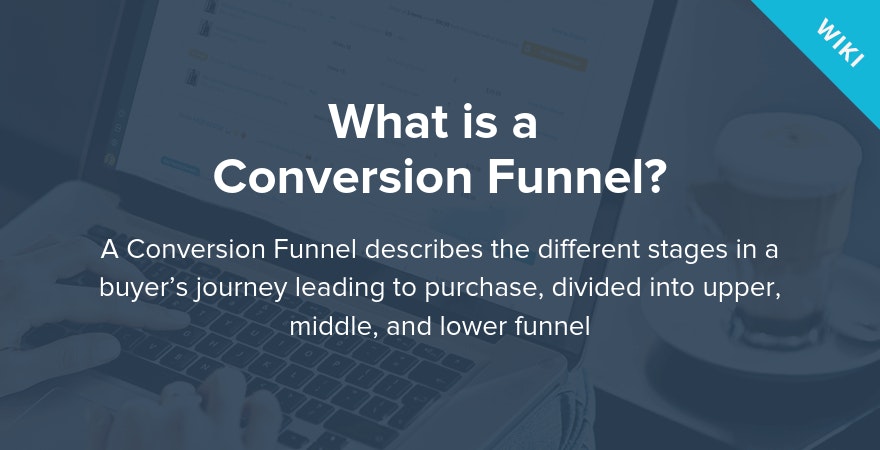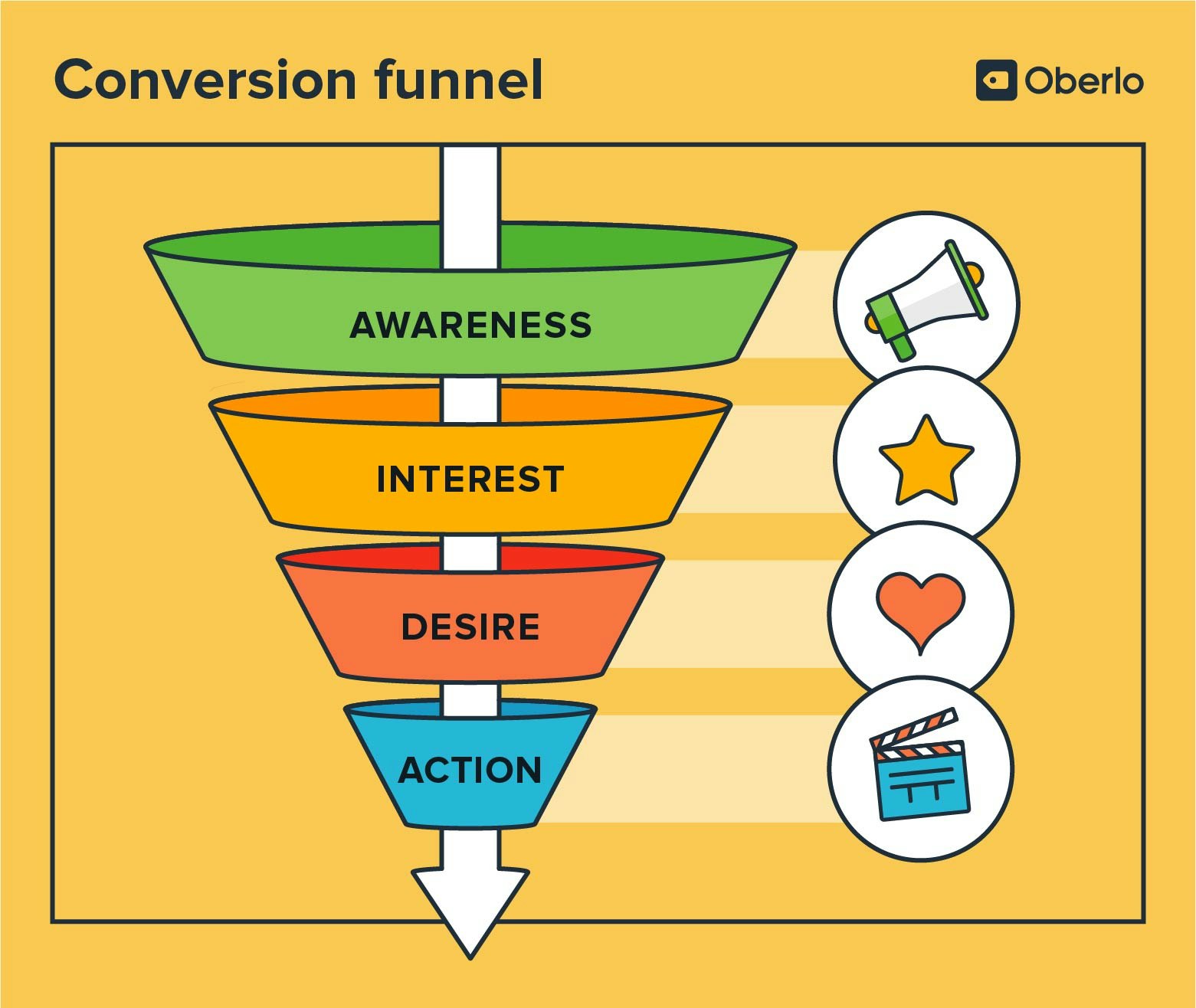
Conversion Funnel



What is a conversion funnel?
In ecommerce, a conversion funnel (sometimes called a sales funnel) is a metaphorical model that illustrates the path a customer takes from their first interaction with a brand, through the purchase of a product or service, and potentially beyond to stages like retention and advocacy.
This path is not always linear and can involve various touchpoints across different sales channels and platforms. For example, a customer might first encounter a brand through a social media ad, later read a blog post linked from an email, and finally make a purchase after clicking on a retargeting ad. Each of these touchpoints contributes to moving the customer further down the funnel.
→ Click Here to Launch Your Online Business with Shopify
When marketers talk about the conversion funnel, they may refer to three distinct levels:
- Top-of-funnel (TOFU): At this level, customers are in the exploration phase. They are discovering new brands, identifying their needs, and becoming aware of potential solutions.
- Middle-of-funnel (MOFU): Here, customers have identified their needs and are actively evaluating different options. They're comparing products, reading reviews, and considering their choices.
- Bottom-of-funnel (BOFU): At this final level, customers are ready to make a purchase. They've done their research, they've evaluated their options, and they're prepared to buy.
Stages of the conversion funnel
The conversion funnel is further divided into stages, each representing a specific point in the customer’s purchase journey. These stages help businesses better understand and address the specific needs of each segment separately.
While there are many different versions of the conversion funnel, they typically address four key stages: awareness, interest, desire, and action.

Awareness
The awareness stage is where potential customers are exploring, discovering new brands, and identifying their needs. They are not necessarily ready to buy, but are gathering information and becoming aware of the options available to them.
The goal for businesses at this stage is to attract these potential customers and make them aware of their brand or product. This is often achieved through brand strategies that increase visibility and provide valuable content, such as educational blog posts, engaging social media content, or informative webinars.
Interest
Customers at the interest stage have identified their needs and are now actively seeking out and evaluating different solutions. They're aware of the brand, are interested in learning more, and businesses are working to show that their offerings are the best solution.
To engage these potential customers, businesses will provide detailed product information, customer testimonials, and may begin building a customer email list. Incentives such as discounts can be offered to first-time subscribers to encourage sign-ups.
Desire
In the desire stage, customers have a clear understanding of their needs and are considering the brand as a potential solution. Trust becomes a key factor, as customers need to feel confident in the brand and its offerings before they are willing to make a purchase.
Businesses aim to help prospects learn more about their brand and products by showcasing the benefits and unique features of their product or service and building trust through transparent and authentic communication.
Targeted email content can also be used to keep prospects engaged and encourage them to return to the site. Offering incentives such as exclusive deals or personalized recommendations can help nurture the customer's desire and move them closer to making a purchase.
Action
The action stage is the final step in the conversion funnel; customers have done their research, evaluated their options, and are ready to take action and make a purchase. To facilitate this, businesses ensure a smooth and easy purchasing process.
This could involve a user-friendly checkout process on an ecommerce site, a variety of payment options, or immediate access to digital products. After the purchase, providing excellent customer service and follow-up communications can help reinforce the customer's decision and enhance their overall experience.
Optimizing your conversion funnel
Understanding the unique needs and behaviors of customers at each stage of the funnel is key to improving your conversion strategy. Here are some detailed strategies for each level:
Top-of-funnel (TOFU) strategies
At the top of the funnel, the focus is on attracting potential customers and increasing brand awareness. Here are some strategies to consider:
- Create engaging content: Develop informative and engaging content that provides value to your audience. This could be blog posts, videos, infographics, or podcasts that address common questions or problems your audience might have. The goal is to attract potential customers to your brand and provide them with valuable information that establishes your brand as a trusted resource.
- Leverage SEO: Use search engine optimization (SEO) techniques to improve your website's visibility in search engine results. This involves using relevant keywords in your content, optimizing your website's structure and speed, and building high-quality backlinks. By improving your SEO, you can attract more organic traffic to your site and reach more potential customers.
- Utilize social media: Regularly post engaging content on social media platforms and interact with your followers. This not only helps to build a strong online presence but also allows you to engage directly with your audience, answer their questions, and build a community around your brand.
Middle-of-funnel (MOFU) strategies
In the middle of the funnel, potential customers are evaluating their options. Your strategies should aim to provide more detailed information and build a stronger relationship with your audience:
- Offer free trials or demos: If your product or service allows for it, offering free trials or demos can be a great way to let potential customers experience what you have to offer firsthand. This gives them a risk-free opportunity to see how your product or service can benefit them and can significantly increase their likelihood of making a purchase.
- Implement email marketing: Build an email list and send out regular newsletters or updates. This keeps your brand at the top of your audience's mind and allows you to share more detailed information about your products or services. You can also use email marketing to share exclusive offers or discounts, further incentivizing potential customers to make a purchase.
- Provide detailed product information: At this stage, customers are looking for more specific information about your offerings. Make sure all product details, pricing, and features are clearly outlined on your website. Providing comprehensive and easy-to-understand information can help potential customers make an informed decision and move closer to making a purchase.
Bottom-of-funnel (BOFU) strategies
At the bottom of the funnel, customers are ready to make a purchase. Your strategies should aim to make this process as smooth as possible and to provide excellent post-purchase service:
- Streamline the checkout process: Make it as easy as possible for customers to complete their purchase. This could involve reducing the number of steps in your checkout process, offering a variety of payment options, or providing clear instructions and assistance. A smooth and easy checkout process can significantly increase your conversion rate.
- Prioritize customer service: Providing excellent customer service can make the difference between a one-time purchase and a loyal customer. Be responsive to customer inquiries and complaints, and go the extra mile to ensure their satisfaction. This not only improves the customer's experience but also builds trust in your brand.
- Follow up after purchase: After a customer has made a purchase, send them a follow-up email to thank them for their business, ask for feedback, or offer related products or services. This not only improves customer satisfaction but also encourages repeat business and helps to build a long-term relationship with your customers.
By tailoring your strategies to each stage of the conversion funnel, you can guide your customers more effectively towards making a purchase and improve your overall conversion rate.